Varied difficulty levels in AP Inter 1st Year Zoology Model Papers and AP Inter 1st Year Zoology Question Paper March 2015 cater to students with diverse academic strengths and challenges.
AP Inter 1st Year Zoology Question Paper March 2015
Time : 3 Hours
Max. Marks: 60
General Instructions:
Note : Read the following instructions carefully.
- Answer All questions of Section A. Answer ANY SIX questions in Section B and answer ANY TWO questions in Section C.
- In Section A questions from Sr. Nos. 1 to 10 are of “Very Short Answer Type”. Each question carries TWO marks. Every answer may be limited to 5 lines. Answer all these questions at one place in the same order.
- In Section ‘B’, questions from Sr. Nos. 11 to 18 are of “Short Answer Type”. Each question carries FOUR marks. Every answer may be limited to 20 lines.
- InSection ‘C’, questions from Sr. Nos. 19 to 21 are of “Long Answer Type”. Each question carries EIGHT marks. Every answer may be limited to 60 lines.
- Draw labelled diagrams wherever necessary in Sections ‘B’ and ‘C’.
Section – A (10 × 2 = 20)
Note : Answer all the questions in 5 lines each.
Question 1.
What is trinominal nomenclature ? Give an example.
Answer:
Trinomial nomenclature is the extension of the binominal system of nomenclature. This system permits the designation of subspecies with a three worded name called trinomen. Subspecies is category below the level of species. Eg: Corvus splendens splendens.
Question 2.
Mention the animals that exhibited a “tube – within – a- tube” organisation for the first time. Name their body cavity.
Answer:
A tube – within – a tube organization for the first time is seen in the group Nematoda. Their body cavity is named as pseudo coelom.
Question 3.
Define ‘Osteon’.
Answer:
In a dense bone a Haversian canal and the surrounding lamillae (rows of osteocytes) and lacunae are collectively called a Haversian system or Osteon.
![]()
Question 4.
Distinguish between a tendon and a ligament.
Answer:
- Tendons attach the skeletal muscles to bones.
- Ligaments attach bones to other bones.
Question 5.
Which arthropod, you have studied, is called a “living fossil” ? Name its respiratory organs.
Answer:
Limulus (king crab) belonging to class Xiphosura of sub phylum chelicerata is called living fossil. It’s respiratory organs are book gills.
Question 6.
Distinguish between Proter and Opisthe.
Answer:
During Transverse binary fission of paramoecium, two daughter paramoecia are formed. The upper or anterior one is proter which receive upper contractile vacuole, cytopharynx and cytostome of its parent. The lower or posterior daughter is opisthe which receives the posterior contractile vacuole only.
Question 7.
What is meant by nocturnal periodicity with reference to the life history of a nematode parasite you have studied ?
Answer:
The microfilaria larvae of wuchereria bancrofti in man move in the peripheral blood circulation during the night time between 10 pm and 4 am. This tendency is referred to as nocturnal periodicity. Ex: Culex.
Question 8.
Name three meninges. In which group of animals do you find all of them ?
Answer:
The three meninges which are brain layers are a) duramater b) Arachnoid membrane c) Piamater.
The group mammals possess all the three layers.
Question 9.
Distinguish between lobopodium and filopodium. Give an example to each of them.
Answer:
a) Blunt finger like pseudopodia are called lobopodium and are seen in Amoeba and Entamoeba.
b) Fibre like pseudopodia are called filopodium and are seen in Euglypha.
![]()
Question 10.
Define Mutualism. Give an example.
Answer:
This type of interaction benefits both the interacting species. Example : Lichens represent an intimate mutualistic relationship between fungus and photosynthetic algae.
Section – B (6 × 4 = 24)
Note : Answer any six questions in 20 lines each.
Question 11.
What is ‘Evil Quartet’ ?
Answer:
The following are the four major causes for accelerated rates of species extinction in the world. These causes are referred to as evil quartet.
a) Habitat loss and fragmentation : These are most important reasons for the loss of biodiversity.
b) Over exploitation : When need turns to greed, it leads to over exploitation.
c) Invasion of Alien species : When Alien species are introduced into a habitat, they turn invasive and establish themselves at the cost of indigenous species.
d) Co – extinctions : In an obligate association between a plant and an animal, if a plant becomes extinct, the animal also becomes extinct as seen in a parasitic and host association.
Question 12.
Give an account of Glandular Epithelium.
Answer:
Some of the columnar or cuboidal cells that get specialised for the production of certain secretions, form glandular epithelium. The glands are of two types – unicellular glands consisting of isolated glandular cells such as goblet cells of the gut, and multicellular glands consisting of clusters of cells such as salivary glands.

On the basis of the mode of pouring of their secretions, glands are divided into two types namely exocrine and endocrine glands. Exocrine glands are provided with ducts; secrete mucus, saliva, earwax (cerumen), oil, milk, digestive enzymes and other cell products. In contrast, endocrine glands are ductless and their products are ‘hormones’, which are not sent out via ducts, but are carried to the target organs by blood. Based on the mode of secretion, exocrine glands are further divided into i. Merocrine glands (e.g. pancreas) which release the secretory granules without the loss of other cellular material ii. Apocrine glands (e.g. mammary glands) in which the apical part of the cell is pinched off along with the secretory product and iii. Holocrine glands (e.g. sebaceous glands), in which the entire cell disintegrates to discharge the contents.
Question 13.
Mention the salient features of Holothuroidea.
Answer:
Holothuroidea-salient features:
- This class includes sea cucumbers.
- Body is elongated in the oro-aboral axis.
- Skin is leathery (coriaceous) and dermis contains loose spicules.
- Arms, spines and pedicellariae are absent.
- Mouth is surrounded by retractile tentacles (modified tube feet useful for feeding).
- Ambulacral grooves are ‘closed’; tube feet bear suckers.
- Madreporite is internal (occurs in coelom).
- Respiratory organs are a pair of cloacal ‘respiratory trees’.
- Development is indirect and includes auricularia larva. Examples : Holothuria, Synapta, Thyone.
Question 14.
What are the modifications that are observed in birds that help them in flight ?
Answer:
1) Body is streamlined.
2) The fore limbs are modified into wings for flight.
3) Skin is dry and devoid of glands, except the oil or preen gland or uropygial gland at the base of the tail to protect tail feathers.
4) Exoskeleton consists of epidermal feathers (a unique feature), with interlocking system.
5) Long bones are hollow with air cavities (pneumatic). Skull is monocondylic. Vertebrae are heterocoelous. The last thoracic, lumbar, sacral and anterior few caudal vertebrae are fused to form a synsacrum. it is fused with pelvic girdle to provide support to hind limbs. A few posterior most caudal vertebrae are fused to form the pygostyle that provides support to the tail feathers. Sternum has a keel/carina for the attachment of flight muscles (except in the ratite birds). Both the clavicles are fused with the interclavicle to form a ‘V’ – shaped bone, called furcula or ‘Wish bone’ or ‘Merry thought bone’.

6) All modern flying birds are provided with powerful breast muscles (flight muscles), chiefly the pectoralis major and pectoralis minor.
![]()
Question 15.
What are lateral appendages ? Based on their presence and absence, write the various types of flagella giving at least one example for each type.
Answer:
Lateral appendages : Some flagella bear one or two or many rows of short, lateral hair like fibrils called lateral appendages. They are of two types namely ‘mastigonemes’ and ‘flimmers’.
Types of Flagella : Based on the presence or absence and / or the number of rows of lateral appendages, five types of flagella are recognised.
a. Stichonematic : This flagellum bears one row of lateral appendages on the axoneme. Eg : Euglena and Astasia.
b. Pantonematic : This flagellum has two or more rows of lateral appendages on the axoneme. Eg : Peranema and Monas.
c. Acronematic : This type of flagellum does not bear lateral appendages and the terminal part of the axoneme is naked without the outer sheath at its tip.
Eg : Chlamydomonas and Polytoma.
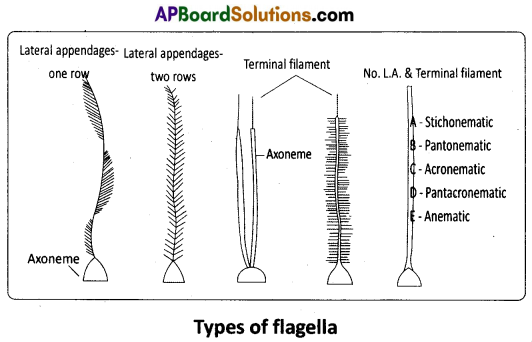
d. Pantacronematic : This type of flagellum is provided with two or more rows of lateral appendages and the axoneme ends in a terminal naked filament. Eg. Urceolus.
e. Anematic or simple : In this type of flagellum, lateral appendages and terminal filament are absent. Hence, it is called anematic (a – no; nematic – threads).
Eg : Chilomonas and Cryptomonas.
Question 16.
Why is adolescence is considered vulnerable phase ?
Answer:
Adolescence : It is the time period between the beginning of puberty and the beginning of adulthood. In other words, it is the bridge linking childhood and adulthood. The age between 12 – 18 years is considered adolescence period. It is both ‘a period and a process’ during which a child becomes mature. It is accompanied by several biological and behavioural changes. Thus, adolescence is a very vulnerable phase of mental and psychological development of an individual.
Question 17.
Draw a neat and labelled diagram of Ommatidium.
Answer:
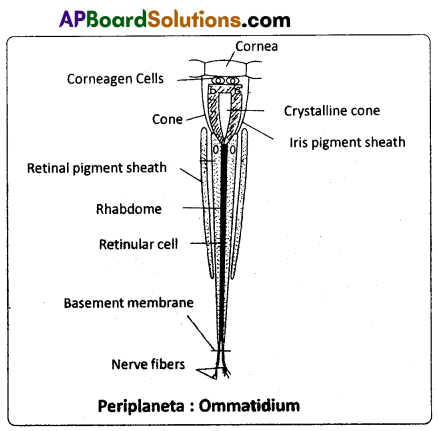
Question 18.
Discuss the causes and effects of “Global Warming”. What measures need to be taken to control “Global Warming” ?
Answer:
Global warming is causing climate changes and is “ilso responsible for the melting of polar ice caps and other snow caps of mountains such as the Himalayas. Over many years, this will result in a rise in sea levels all over the world that can submerge many coastal areas. The total spectrum of changes that global warming can bring about is a subject that is still under active research.
Global warming – Control measures :
- The measures include cutting down use of fossil fuels
- Improving efficiency of energy usage.
- Planting of trees, and avoiding deforestation
- Slowing down the growth of human population.
![]()
Section – C (2 × 8 = 16)
Note : Answer any two questions in 60 lines each.
Question 19.
Explain the structure and life cycle of Entamoeba histolytica with the help of neat and labelled diagram.
Answer:
Structure : Entamoeba histolytica passes through three distinct stages in its life cycle, namely :
i) Trophozoite stage
ii) Precystic stage and
iii) Cystic stage
Trophozoite stage : It is the most active, motile, feeding and pathogenic stage that lives in the mucosa and sub-mucosa membranes of the large intestine. It moves with the help of a single blunt finger like pseudopodium called lobopodlum which is produced anteriorly. The body of the trophozoite is surrounded by plasmalemma. Its cytoplasm is differentiated into an outer clear, viscous, non-granular ectoplasm and the inner fluid like, granular endoplasm. Ribosomes, food vacuoles and a vesicular, cartwheel shaped nucleus are present in the endoplasm. However contractile vacuoles, endoplasmic reticulum, Golgi apparatus and mitochondria are absent.
The absence of mitochondria indicates the ‘obligate anaerobic nature’ of Entamoeba histolytica. It produces the proteolytic enzyme called histolysin due to which the species name histolytica’ was assigned to it. Due to the effect of this enzyme, the mucosa and sub-mucosa of the gut wall are dissolved releasing some amount of blood, tissue debris which are ingested by the trophozoites. Hence, the food vacuoles are with erythrocytes, fragments of epithelial cells and bacteria. The mode of nutrition is holozoic. Presence of ‘RBC in food vacuoles’ and cartwheel shaped nucleus are the characteristic features of the trophozoites of Entamoeba histolytica.
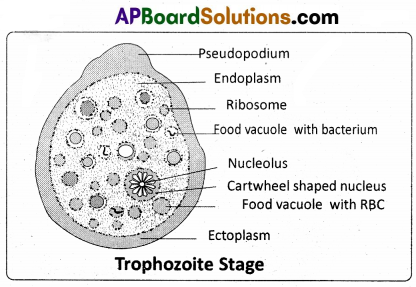
Precystic stage : It is the non – feeding and non-pathogenic stage of Entamoeba histolytica that is found in the lumen of the large intestine. It is a small, spherical or oval, non- motile form. The cytoplasm of the precystic stage stores glycogen granules and chromatoid bars (made of ribonucleo protein) which act as reserve food.

Cystic stage : It is round in shape and is surrounded by a thin, delicate and highly resistant cyst wall. It is found in the lumen of the large intestine. The process of development of cyst wall is called encystation which is a means to tide over the unfavourable conditions that the parasite is going to encounter while passing to a new host. Soon after the encystation, the nucleus undergoes two successive mitotic divisions to form four daughter nuclei. This type of cystic stage is called tetra nucleate cyst or mature cyst which is ‘the stage infective to man’.

Life cycle : The trophozoites undergo binary fissions in the wall of the large intestine and produce a number of daughter entamoebae. They feed upon the bacteria and the host’s tissue elements, grow in size and again multiply. After repeated binary fissions, when the trophozoites increase in number, some of the young ones enter the lumen of the large intestine and transform into precystic stages. Here, the precystic stages transform into cystic stages which in turn develop into the tetranucleate cysts.
The entire process is compelted only in a few hours. These tetranucleate cysts come out along with the faecal matter and can remain alive for about 10 days. These cysts reach new host through contaminated food and water. They pass into the small intestine of a new human host where the cyst wall gets ruptured by the action of the enzyme trypsin, releasing the tetranucleate amoebae. Such tetranucleate excystic amoebae are called metacysts.
The four nuclei of the metacyst undergo mitotic divisions and produce eight nuclei. Each nucleus gets a bit of the cytoplasm and thus eight daughter entamoebae or ‘metacystic trophozoites’ are produced. These young ones develop into feeding stages called trophozoites. They invade the mucous membrane of the large intestine and grow into mature trophozoites.
Pathogenicity :
The trophozoites ‘dissolve’ the mucosa! lining by histolysin, go deep into sub-mucosa and cause ulcers. These ulcers contain cellular debris, lymphocytes, blood corpuscles and bacteria. It leads to the formation of abscesses in the wall of large intestine . Ultimately it results in stool with biood and mucous. This condition is called amoebic dysentery or intestinal amoebiasis or tropical amoebiasis. Some people do not exhibit any symptoms. Such people are called ‘carriers or asymptomatic cyst passers’ as their stool contains the tetranucleate cysts. They help in spreading the parasites to other persons.
Extra-intestinal amoebiasis : Sometimes, the trophozoites may “upture the wall of capillaries, enter the blood stream, and primarily reach the liver where they may cause ‘abscesses’ (some call it ‘secondary amoebiasis’). From there, they may go to lungs, heart, brain, kidneys, gonads, etc., cause abscesses in those parts leading to severe pathological conditions.
![]()
Question 20.
Describe the Blood circulatory system of Periplaneta in detail and draw a neat and labelled diagram of it.
Answer:
Circulatory system of Periplaneta : The circulatory system helps in the transportation of digested food, hormones etc., from one part to another in the body. Periplaneta has an open type of circulatory system as the blood, or haemohymph, flows freely within the body cavity or haemocoel. Blood vessels are poorly developed and open into spaces. Visceral organs located in the haemocoel are bathed in the blood. The three main parts associ-ated with the blood circulatory system of Periplaneta are the haemocoel, heart, and blood.
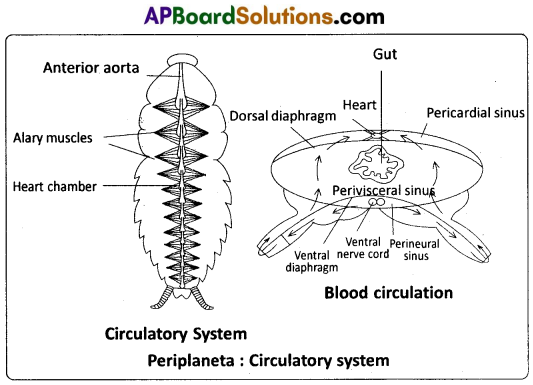
Haemocoel : The haemocoel of cockroach is divided into three sinuses by two muscular, horizontal membranes, called dorsal diaphragm or ‘pericardial septum’ and ventral diaphragm. Both the diaphragms have pores. There is a series of paired triangular muscles, called alary muscles. Every segment has one pair of these muscles situated on the lateral sides of the body. These are attached to the pericardial septum by their broad bases and to the terga by their pointed ends or apices. The three sinuses of the haemocoel are known as pericardial haemocoel or the ‘dorsal sinus’, the perivisceral haemocoel or the ‘middle sinus’ and eternal haemocoel or ‘vental sinus’ or ‘perineural sinus’. The middle sinus is very large as it contains most of the viscera. The dorsal and ventral sinuses are small as they have only heart and nerve cord, respectively.
Heart : the heart lies in the pericardial haemocoel or dorsal sinus. It is a long, muscular, contractile tube found along the mid dorsal line, beneath the terga of the thorax and abdomen. It consists of 13 chambers. Every chamber opens into the other present in front of it. Three of the thirteen chambers are situated in the thorax and ten in the abdomen. Its posterior end is closed while the anterior end is continued forward as the anterior aorta. At the posterior side of each chamber, except the last, there is a pair of small apertures called ostia’ one on each side. Ostia have valves which allow the blood to pass only into the heart from the dorsal sinus.
Blood : The blood of Periplaneta is colourless and is called haemolymph. it consists of a fluid called plasma, and free blood corpuscles or haemocytes, which are ‘phagocytic’. The phagocytes are large in size and can ‘ingest’ foreign particles such as bacteria. There is no respiratory pigment in the blood and so it plays no major role in respiration. The important functions of the blood are :
- It absorbs digested food from the alimentary canal and distributes it to the rest of the body.
- It brings nitrogenous wastes from all parts of the body to the excretory organs for their elimination.
- It carries defensive phagocytes to the places of infection where they engulf the germs and disintegrating tissue parts.
- It transports secretions of the ductless glands to the target organs.
Circulation of blood: The blood flows forward in the heart by the contractions of its chambers. At the anterior end of the heart, the blood flows into the aorta and from there it enters the sinus of the head. From the head sinus, the blood flows into the perivisceral and sternal sinuses. On contraction of the alary muscles the pericardial septum is pulled down. This increases the volume of the pericardial sinus. Hence blood flows from the perivisceral sinus into the pericardial sinus through the appertures of the pericardial septum. On relaxation of the alary muscles, the pericardial septum moves upwards to its original position. This forces the blood, to enter the chambers of the heart through the ostia from the pericardial sinus.
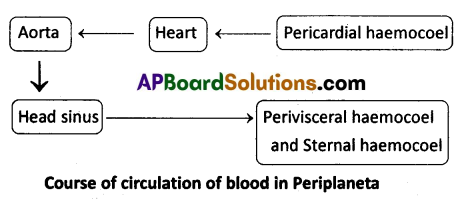
![]()
Question 21.
Give an account of flow of energy in an ecosystem.
Answer:
Energy Flow : Except for the deep sea hydro-thermal ecosystem, sun is the only source of energy for all ecosystems on Earth. Of the incident solar radiation less than 50 per cent of it is photosyn- thetically active radiation (PAR). We know that plants and photosynthetic bacteria (autotrophs), fix Sun’s radiant energy to synthesise food from simple inorganic materials. Plants capture only 2 – 10 percent of the PAR and this small amount of energy sustains the entire living world.
So, it is very important to know how the solar energy captured by plants flows through different organisms of an ecosystem. All heterotrophs are dependent on the producers for their food, either directly or indirectly. The law of conservation of energy is the first law of thermodynamics. It states that energy may transform from one form into another form, but it is neither created nor destroyed. The energy that reaches earth is balanced by the energy that leaves the surface of the earth as invisible heart radiation.
The energy transfers in an ecosystem are essential for sustaining life. Without energy transfers there could be no life and ecosystems. Living beings are the natural proliferations that depend on the continuous inflow of concentrated energy.
Further, ecosystems are not exempted from the Second Law of thermodynamics. It states that no process involving energy transformation will spontaneously occur unless there is degradation of energy. As per the second law of thermodynamics – the energy dispersed is in the form of unavailable heat energy, and constitutes the entropy (energy lost or not available for work in a system). The organisms need a constant supply of energy to synthesize the molecules they require.
The transfer of energy through a food chain is known as energy flow. A constant input of mostly solar energy is the basic requirement for any ecosystem to function. The important point to note is that the amount of energy available decreases at successive trophic levels. When an organism dies, it is converted to detritus or dead biomass that serves as a source of energy for the decomposers. Organisms at each trophic level depend on those at the lower trophic level, for their energy demands.
Each trophic level has a certain mass of living material at a particular time, and it is called the standing crop. The standing crop is measured as the mass of living organisms (biomass) or the number of organisms per unit area. The biomass of a species is expressed in terms of fresh or dry weight (dry weight is more accurate because water contains no usable energy).
The 10 percent Law: The 10 percent law for the transfer of energy from one trophic level to the next was introduced by Lindeman (the Founder of the modern Ecosystem Ecology). According to this law, during the transfer of energy from one trophic level to the next, only about 10 percent of the energy is stored / converted as body mass / biomass. The remaining is lost during the transfer or broken down in catabolic activities (Respiration).

Lindeman’s rule of trophic efficiency /Gross ecological efficiency is one of the earliest and most widely used measures of ecological efficiency. For example, if the NPP (Net primary production) in a plant is 100 kJ, the organic substance converted into body mass of the herbivores which feeds on it is 10 kJ only. Similarly the body mass of the carnivore -I is 1 kJ only.